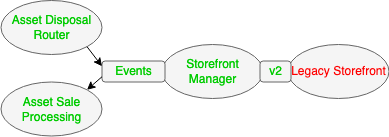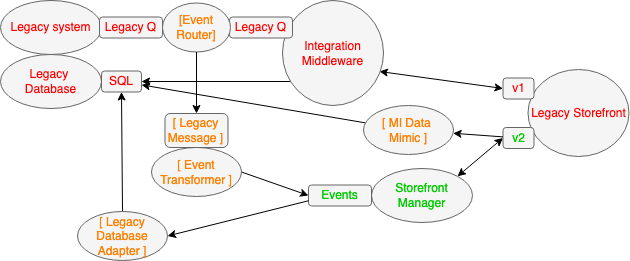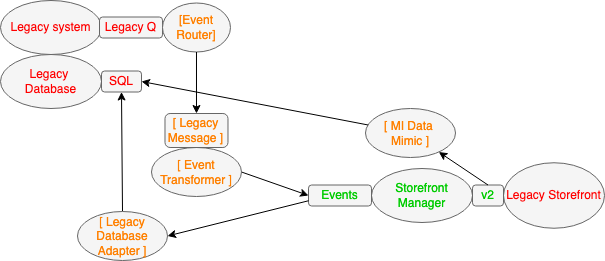The core to a successful legacy displacement is the gradual replacement of legacy with new software, as this allows
benefits to delivered early and circumvents the risks of a Big Bang. During displacement the legacy and new system
will have to operate simultaneously allowing behavior to be split between old and new. Furthermore that division of
labor between the two will change regularly as the legacy withers away.
To allow this interplay between legacy and new, we need to build and evolve Transitional
Architecture that supports this collaboration as it changes over time. Intermediate configurations may require
integrations that have no place in the target architecture of the new system.
Or to put this more directly – you will have to invest in work that will be thrown away.
How It Works
Consider the renovation of a building. An architect has provided
you with renderings of the finished product and builders are standing by to start. But the first step is to put
scaffolding up on the building site.
Hiring the scaffolding itself and paying a team to construct it is an unavoidable investment. It is needed to
enable critical work to be done, and buys risk mitigation during the renovation increasing the safety of the workers.
It may even unlock new options – allowing you to fix the chimney while the roof is being replaced or attend to the
overhanging trees (to stretch the metaphor a bit further). Once the work is
completed, another team will arrive and dismantle the scaffold, and you are
pleased to see it go.
In a legacy displacement context, this scaffolding consists of software components
that ease, or enable building the current evolutionary step towards the target architecture. Like scaffold, these
software components are not needed once that target architecture has been reached and must be removed.
Replacing a large legacy monolith in one go is risky and we can improve the
safety to the business by displacing it in several steps. We may do this by
subset of functionality, or a subset of data, using such patterns as
Extract Value Streams and Extract Product Lines. To do any of this we need to break the
monolith up, which entails introducing seams into the monolith to separate its
pieces. Components that introduce a seam to the monolith are Transitional Architecture because
they will necessarily disappear once the monolith is displaced, they also
aren’t needed for the monolith to fulfil its existing duties.
We can introduce a seam by looking at how different parts of the monolith
communicate with each other, and placing a component in the communication path
that we modify to divert or duplicate traffic to other elements. Event Interception does this with communication via events,
Branch by Abstraction does this with APIs. . As we create
these seams we can introduce Legacy Mimics
to introduce new components to the legacy communication flows.
One of the biggest challenges with legacy displacement is dealing with
data, which legacy systems often access directly. If possible it’s wise to
introduce a seam by replacing direct data access by introducing an API – such as adopting the Repository pattern.
But when we can’t do that we need to replicate the state of a system. Legacy Mimics and Event Interception are both useful once we need to go down this
path.
Even with a clear destination architecture in mind, there are many pathways to get
there. Each of the different paths a team could take will be enabled by, or
require different Transitional Architecture to be put in place. In this case we need to do a
cost/benefit analysis for each path, to enough detail that we can see if it
makes an impact on the choice.
Remember that part of using a Transitional Architecture is removing it when it’s no longer
needed. It may be worth investing a little more when building it to add
affordances that make it easier to remove later. Similarly we need to ensure
that it is properly removed – unnecessary components, even if unused, can
complicate the efforts of future teams to maintain and evolve a system.
When to Use It
Nobody likes to waste hard work, and that sentiment naturally arises when
we talk of building something that we intend to throw away. It’s easy to
conclude that something that is disposable has little value. But a Transitional Architecture
delivers value in a couple of ways, and this value should be compared to the
cost of building it.
The first value is that it often improves the speed of delivering a feature
to the business. A handy metaphor here is using painters tape over the trim when
painting a wall. Without taping the trim, you have to paint carefully and slowly
near the trim. The cost of placing the tape before, and removing the tape
afterwards, is made up by the increased speed (and reduced skill) needed to
avoid getting paint on the wrong place.
This trade-off in software is magnified by the importance of time-to-value.
If the business needs a new dashboard that integrates existing data from the
legacy system being displaced with data from the new systems, you can get
there quicker by building a gateway in your new dashboard that reads and
coverts legacy-sourced data into the format required for the dashboard. This
gateway will be discarded once the legacy system is removed, but the value of
having an integrated dashboard for time before the replacement happens may
well exceed the cost of creating it. If the comparison is close, we should
also consider the chance of the legacy replacement taking longer than
expected.
The second value of a Transitional Architecture is how it can reduce the risk of legacy
displacement. Adding Event Interception to a customer
management system will cost something to build, but once built it allows
gradual migration of customers (eg using Extract Product Lines or Extract Value Streams). Migrating a subset of customers reduces the
chances of something going seriously wrong in the migration and tends to reduce
the impact of anything that does go pear-shaped. Furthermore, should a really
serious problem crop up, Event Interception makes it easy
to revert back to the previous state.
As a rule, teams should always consider Transitional Architecture during a legacy
displacement, and brainstorm different ways building some temporary
software could realise these benefits. The team should then evaluate the
benefits of increased time to value and reduced risk against the cost of
building this short-lived software. We think many people would be surprised by
how frequently temporary software repays its cost.
Example: Architecture Evolution
This section explores the Middleware removal example introduced within the overview article, and describes how
Transitional Architecture enabled the safe evolution of the system.
Legacy configuration
As described in the overview the as-is architecture consisted of the main Legacy system responsible for pricing
and publishing products to the Legacy Storefront via some Integration Middleware. That middleware consumed
product published events from a Legacy Queue and handled the long running orchestration of how the product was
presented on the storefront. When the product is sold the Legacy Storefront calls the middleware which updates
the products status within the underlying shared Legacy Database. The Legacy Middleware also stored its internal
state within the Legacy Database which fed into critical reports via the data warehouse. See Critical Aggregator

Target Architecture
Within the target architecture the Legacy Storefront remains, but has some of it’s responsibilities moved into a
new Storefront Manager component. The Storefront Manager will consume business Events produced by the Asset
Disposal Router when a product gets routed to that channel for sale, and will publish the product onto the
Storefront using a new API.
The Storefront Manager will be responsible for how the product is displayed within the Storefront. When
products are sold, the Legacy Storefront calls the Storefront manager using the new API which then emits a
business Event to be consumed by a down stream Asset Sale Processing component.

The first small enabling step
The first bit of Transitional Architecture to be added was the Event Router component. This is an example of the Event Interception pattern.
The Event Router created a technical seam that could be exploited to route products for sale via new components.

Introduction of the Storefront Manager
The next step was to add the new Storefront Manager. Transitional Architecture was also added here, that served
two very different purposes. Namely to isolate the new components from legacy concerns (e.g. data structures
and messages) and to keep the lights on within the legacy world.
For isolation (Anti-corruption Layer) an Event Transformer was created to transform the Legacy Message being
routed by the Event Router into a new and clean business event format to be consumed by the
Storefront Manager, and that would endure within the target architecture.
The Storefront Manager and Legacy Storefront would collaborate via a new API, so this was added, as well as
internal Event Interception so that when a product was sold, the Legacy Storefront would
“call back” to the system that published that product.
To keep the lights on two bits of Transitional Architecture were required. Firstly when products were sold new
business events were published. These were consumed by a temporary Legacy Database Adapter that mimicked the
Integration Middleware, updating the Legacy Database with the sale information. Secondly the MI Data Mimic was
created. This was both an Event Interceptor and a Legacy Mimic – it intercepted events within the new API and
updated the Legacy Database with the “state” information required by the business critical reports.

Business outcome – decommissioning of the Legacy Middleware
The Legacy System was still responsible for determining which assets could be sold, and sending products for
publishing, but over time the number of products routed to the new components was increased (see
Extract Product Lines) until 100% of the traffic was being processed without reliance on the
Legacy Middleware. At this point it was possible to decommission the Legacy Middleware, leaving the new
Storefront Manager and Transitional Architecture components in production.

Introduction of the Asset Disposal Router
After some time the new Asset Disposal Router component was brought on line. (Remembering that this example is
somewhat simplified and drawn from the experiences of a much larger Legacy Displacement programme.)
That component published the new business Events for products that could be consumed by the Storefront Manager.
There was no longer a need for the Event Router as other components had taken over determining which assets were
for disposal, nor the Event Transformer – so these components could be decommissioned.
As the Legacy Middleware had been decommissioned the business critical reports had been changed to use data from
the new components (see Revert to Source) and so the MI Data Mimic component could also be
decommissioned.

Safe arrival at the target architecture
Sometime later the new Asset Sale Processing component was brought online which took over the last set of
responsibilities from the Legacy System (within scope of this example).
At that time the last of the Transitional Architecture, the Legacy Database Adapter, could be removed. The
business Events produced by the Storefront Manager were consumed by the Asset Sale Processing component.

